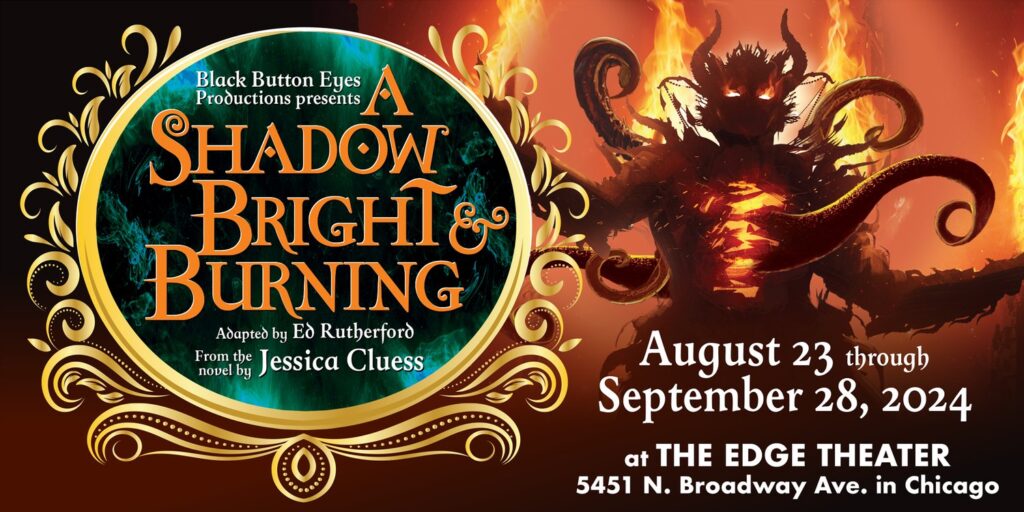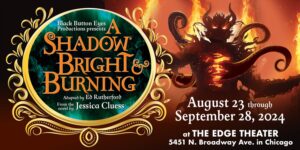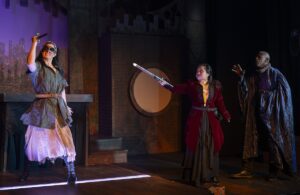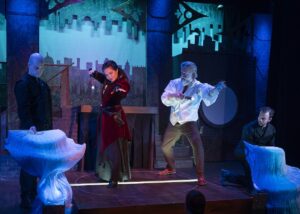
 *** “A Shadow Bright & Burning” focuses on an energetic young woman named Henrietta Howell (Annemarie Andaleon), who is unsure of what her magical powers really are—and who she really is. Adapted by director Ed Rutherford from the novel by Jessica Cluess, this is a tale about how Henrietta evolves into a full-fledged sorcerer and about the people she encounters along her journey. While the production is quite good, the story does not successfully make the leap from book to stage play. The reason is that the original fantasy, while excellent, is somewhat too complicated and nuanced for a theatregoer to follow easily. There are a few too many characters to keep track of, and it becomes quite a chore to keep the various plotlines and plot twists straight.
*** “A Shadow Bright & Burning” focuses on an energetic young woman named Henrietta Howell (Annemarie Andaleon), who is unsure of what her magical powers really are—and who she really is. Adapted by director Ed Rutherford from the novel by Jessica Cluess, this is a tale about how Henrietta evolves into a full-fledged sorcerer and about the people she encounters along her journey. While the production is quite good, the story does not successfully make the leap from book to stage play. The reason is that the original fantasy, while excellent, is somewhat too complicated and nuanced for a theatregoer to follow easily. There are a few too many characters to keep track of, and it becomes quite a chore to keep the various plotlines and plot twists straight.
Set in the early days of Victorian England, the tale begins when Howell discovers that she can burst into flames but knows that she is not a witch. Discovered by a sorcerer par excellence named Cornelius Agrippa (Timothy Griffin), she is talked into attending a school for royal sorcerers and is thought to be the first female sorcerer to come about in 400 years, that is, since Joan of Arc. Agrippa and others believe that she might be the Chosen One, prophesized to defeat the Ancients, terrifying demons from another dimension who threaten humanity—and who have invaded Britain through an opening of a supernatural porthole. The Ancients are represented by their leader Cortison, a man who has no skin.
At the beginning, we come to understand how the practitioners of wizardry and ritual magic are distinguished, that is, how sorcerers differ from magicians who differ from witches. Over time, we witness the shattering of the underlying premises regarding such stereotypes. The first stereotype has to do with women generally not practicing sorcery as compared to men and sorcery being the highest form of wizardry. The second stereotype has to do with the social class basis of who may or may not be privy to ritual magic; traditionally, being a witch has been considered the purview of low-class women, with men of higher status being magicians. And the third stereotype has to do with the distinction between white and black magic, that being used for good purposes versus evil ones. Then, as a consequence of all of these stereotypes about various practitioners, many are forced to practice their craft secretly. The show ultimately makes the point that whether magic is good or evil is a matter of intent, and its power has to do with the inner strength of the individual. Hence, this is also a story about the need to come out in the open and work your own individual style of magic. In so doing, you can become the best person that you were meant to be.
Needless to say, Henrietta ultimately shatters expectations regarding class-based and sex-biased magical practices while simultaneously making a tremendous impact on the men surrounding her. Above all, we witness how she becomes stronger as she realizes her own talent and becomes more empowered.
Andaleon is cast well in her role—her acting is solid and engaging—and she is the focus of every scene in the show. By and large, the acting among all is great, and the intentional overacting is hilarious. Notable is Peter Ruger in the role of Lambe with his red glasses; he is funny every time he takes the stage. I particularly liked watching the range of characters that Jamie Dillon Grossman plays as Sarah, Charlie, and Queen Victoria. Other actors include: Sierra Buffum (Cellini), Kat Evans (Lily, Familiar), Alex George (Rook), Jessica Goforth (Colegrind, Palehook), North Homewood (Blackwood), Darren Jones (Hargrove), Jason LaCombe (R’hlem), David Lipschutz (Magnus), and Ensemble members Jennifer L. Mickelson and Troy Schaeflein.
Lots of elements in this fantasy are exceedingly well done, and the stage effects (simulating fire and water, etc.) are especially clever and amusing, thanks to set and prop design by Jeremiah Barr. The multi-purpose cityscape plus staircases set has been lovingly created, and the drawing on two walls alludes to the occult: They feature a horoscope-like symbol with a five-pointed star in the middle and a circular track representing the orbit of one or more planets. The set especially looks great in conjunction with Liz Cooper’s lighting design. When we enter the theatre, we immediately notice the illumination by turquoise and dark magenta lights, which lend a mystical flavor to the environs. Also notable are the green and purple lights when Hargrove the Magician is on stage. That said, the audience has to imagine all the various settings for the most part. Costume design by Rachel M. Sypniewski cannot be excelled. She portrays the flash of the magicians, the majesty of the queen, and the poverty of the working classes. The use of black fabric in so many garments provides an element of sadness and doom but is very indicative of the clothing worn in the Victorian Age. Also enjoyable to watch is Derek Van Barham’s choreography and Brendan Hutt’s violence design.
The biggest problem with this presentation is that there is too much of a “data dump” at the beginning of the first act in order to bring the audience up to speed. In fact, there are a few too many expositions throughout, but things get better in the second act once the audience has become better acquainted with the characters and the story. Unfortunately, the use of so much verbiage serves to distance the audience from the characters rather than to make them appear more realistic and more worthy of empathy.
All told, the play has the feel of something that could have been written contemporaneously in the early 1800s rather than today. The ending is almost Shakespearean. Henrietta’s journey almost mirrors the rise of Queen Victoria to the throne, with two strong and brave women defending Britain and advocating feminine achievement. In addition to the play’s serious tone, there are moments of widely intentional humor and other moments when the show can be so dark that it becomes funny—but, then again, sometimes not. However, if you can sit back and not work so hard to analyze everything and instead just take things as they come, you are much better off. While some of the characters could have been merged and some elements of the plot simplified, this may not have been the solution when adapting this story. Yes, we can definitely follow the gist of the tale and grasp its deeper meaning and nuance. But when the script does not work as well as intended, then a clever fantasy does not have the impact that it should.
“A Shadow Bright & Burning” is playing through September 28, 2024, at The Edge Theater, 5451 N. Broadway, in Chicago.
General admission tickets are $40.
Performance schedule:
Thursdays, Fridays, and Saturdays – 7:30 p.m.
Sundays – 3:00 p.m.
Plus one additional Industry Performance on Tuesday, September 10th at 7:30 p.m.
For more information and to purchase tickets, visit https://www.blackbuttoneyes.com/
To see what others are saying, visit www.theatreinchicago.com, go to Review Round-Up and click at “A Shadow Bright and Burning”.






More Stories
“The Magic School Bus: Lost in the Solar System”
“February House” reviewed by Julia W. Rath
” A Lie of The Mind”